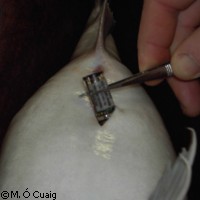How they grow and where they go: fishermen and scientists track cod in the Celtic Sea
Fishermen and scientists in Ireland are working together to study cod in the Celtic Sea using a high-tech tagging device. Cod that were tagged in spring 2007 are now being re-captured by fishermen who, together with researchers at the Marine Institute, are studying the growth and behaviour of these important fish. The project is funded indirectly by the EU's Financial Instrument for Fisheries Guidance (FIFG). In response to reports by fishermen that cod breeding areas protected from fishing were probably robust enough to be harvested, Ireland's Marine Institute launched a study into the growth and migration patterns of Celtic Sea cod. Using a combination of conventional and high-tech tracking devices, scientists and commercial fishermen teamed up to capture, tag and re-release 4,063 cod in the Celtic Sea. Two different groups of cod that live in proximity were collected: larger, spawning cod were captured offshore and smaller fish were caught in nurseries inshore. This will allow the scientists to study a wide range of behaviours. The captured fish were all given a conventional numbered tag (about the size of a plastic tag that holds pairs of socks together) attached to the dorsal fin using a device like an ear-piercing gun. This tag is clearly visible to fishermen, who can set aside the fish, measure and weigh it, and deliver it to the research team for further study. Some of the larger fish (longer than 50 cm) were also given a data storage tag (DST), which was surgically inserted into the fish's belly. These tags measure and record temperature and pressure (i.e. depth) every four minutes for a period of up to two years. Inserting the DST is no small matter. The cod must be captured using nets brought up very slowly from the bottom to avoid giving the fish the bends (air in the bladder can expand and cause death if they are brought up too quickly). Selected fish are put into an anaesthesia tank and then placed in a special 'cradle' with water running over it so that the researcher can surgically insert the tag. The fish are stitched up and put into a recovery-and-observation tank before being re-released into the sea. The stop-and-start measurement data collected using the conventional tags are valuable, but the DSTs fill in the blanks concerning where the fish have been and what they've been up to. By capturing cod which live close to one another but are at different stages of their lives, and by using a combination of data-gathering devices, explained Macdara Ó Cuaig, a researcher at the Marine Institute, 'we can look at how they grow and where they go.' To date, around 10% of the tagged fish have been returned by fishermen, anglers and processors from Ireland, Spain, France and the UK. The temperature and pressure data recorded by the DSTs can be compared to known temperature and depth data for the area, which gives clues as to when and where fish move into shallow or deep waters, or rise to the surface to feed or breed. Simulations of the fish's growth and migration can then be run, which offers a more realistic idea of what they are doing. 'What makes this project such a success,' said Mr Ó Cuaig, 'is that every fish that is recaptured and reported adds its own piece of information to the jigsaw and helps us get a better understanding of the stock.' The study's results so far indicate that Celtic Sea cod have high growth rates. 'A fish reported to us last month with a conventional tag not only confirmed the rapid growth associated with Celtic Sea cod, but also has the unique distinction of being caught three times and released twice,' explained Mr Ó Cuaig. 'This fish had a total of a 16-fold increase in weight in just 15 months! This demonstrates the potential yield possible from the Celtic Sea cod stock.' The main strength of the study, according to Mr Ó Cuaig, is that scientists and fishermen are working closely and in cooperation with one another. 'The most encouraging aspect of the project is the results we can get by combining the knowledge and skill of the fishermen with that of the scientists, with the common goal of learning more about the cod stock,' he said. 'Fisheries-science partnership is at its best.' If you spot a tagged fish, keep in mind that it has a story to tell and may carry a reward.
Countries
Ireland



